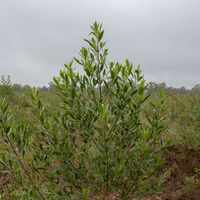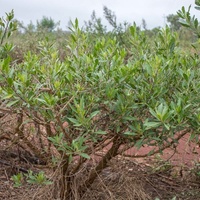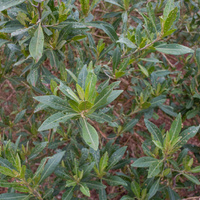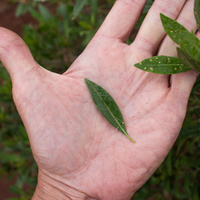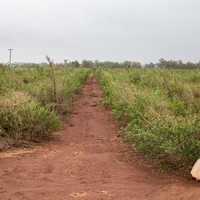Common name: Corkwood
Other common names: Eye opening tree, Eyeplant, Soft corkwood, Poison corkwood, Poisonous corkwood, Soft corkwood, Yellow basswood
Description
Corkwood is an Australian native tree whose leaves contain alkaloids used in medicine.
Its natural range extends along Australia's east coast, from subtropical New South Wales to tropical north Queensland, as far north as the town of Cooktown and also occurs on the neighbouring island of New Caledonia, a French-dependent territory. It is cultivated commercially in Australia, India and Japan.
It may reach up to 18 m (60 ft) tall in the cooler, wetter parts of its range but is more typically a small tree 5 to 10 m (16 to 33 ft) tall with a crooked trunk supporting a densely leafy rounded or pyramidal crown. The bark is pale grey or brown, soft, corky and deeply furrowed on mature trees.
Leaves are elongated oval or club-shaped, 8 to 15 cm (3 to 6 in) long, dull green on both sides and alternately arranged along the ends of the branches. They remain on the plant throughout the year.
Flowers are trumpet-shaped, five-lobed at the lip, white or pale lilac with purple striping in the throat and in clusters arising at the leaf base. They bloom from autumn to spring and are followed, if fertilised, by small round berries, green when young, purple-black when ripe, enclosing two to four longish seed.
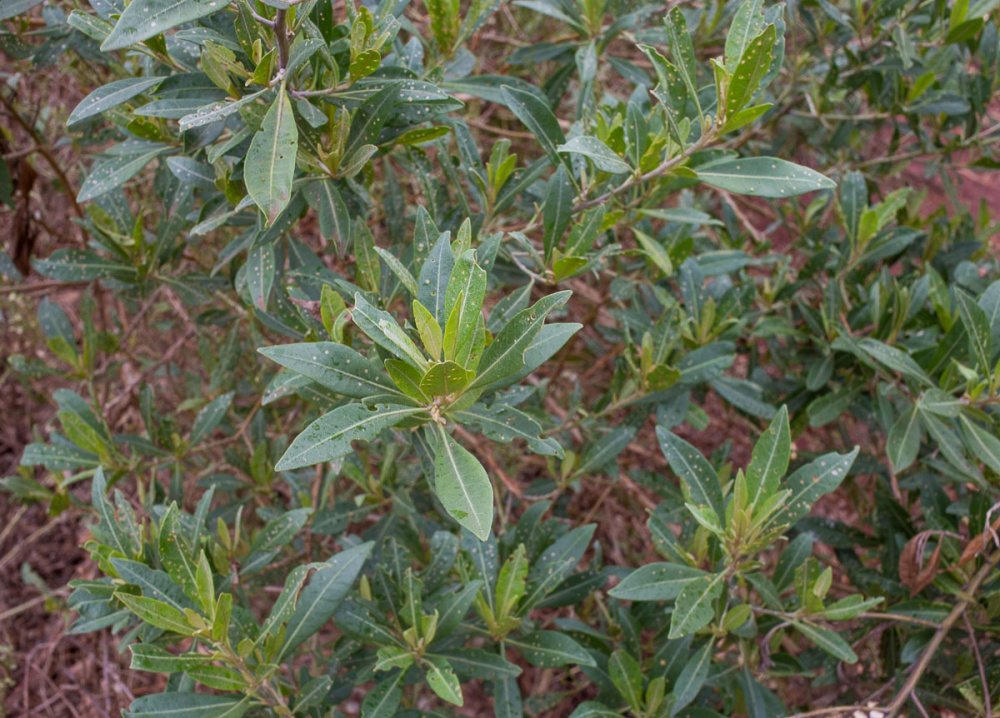
Health use
The leaves are the principal source of the alkaloids Scopolamine (Hyoscine) and Hyoscyamine, which have mydriatic, anticholinergic and antispasmodic action.
Scopolamine (Hyoscine) is commonly used to treat postoperative nausea and vomiting, motion or travel sickness, cancer therapy's side effects, and to dilate pupils in eye surgery. It was used in the past to treat shell shock suffered by soldiers in the Second World War. One of the medicines it is used in is Buscopan, an anticholinergic.
Hyoscyamine is used to treat respiratory diseases such as asthma, intestinal disorders and peptic ulcers.
Other uses
The soft, light yellow wood is useful for cabinetwork. Still, most logs come in diameters too small to make sawing them into lumber practical. It is sometimes used for carvings.
General interest
Scopolamine (Hyoscine) belongs to a group of alkaloid chemicals found in plants of the Nightshade (Solanaceae) family, which have constituents with a potent effect on the human central nervous system. Well-known alkaloids include strychnine, morphine, cocaine and nicotine.
Climate
Grows naturally in moderately humid subtropical and tropical climates, generally areas with annual lows of 12 to 22°C, annual highs of 23 to 30°C, annual rainfall of 1000 to 2500 mm and a dry season of 5 months or less.
Corkwood is also commercially cultivated with irrigation in drier areas, such as in Kingaroy, Queensland, Australia, which receives 800 mm annual rainfall and experiences a dry season of 6 months.
Growing
New plants can be grown from seed or cuttings. Cuttings are preferred as this allows planting material to be selected from high leaf-yielding and high-alkaloid-content cultivars.
Performs best on free-draining loam and sand soils of an acid to neutral nature, generally with a pH of 4.5 to 7.0, and on sites with full to partial sun exposure. It has poor tolerance to pronounced drought conditions.
In commercial operation, harvesting starts about six months after transplanting and is usually mechanical, stripping the leaves and stems and cutting the plant back to around 1 m (3 ft) tall. Harvesting is repeated at four- to six-month intervals for about five years, then replanting is done.
For extracting the alkaloids, the harvested material is cut, chopped, dried (either air-dried or using heat) and sieved to separate out the leaf from the woody material. The resulting leaf portion is then subjected to an extraction process using solvents.
The total alkaloid content of the leaves is around 3%. Roughly 12,000 kgs of fresh leaves are harvested per hectare, per year, in commercial operations (the equivalent of 10,700 lbs per acre, per year).
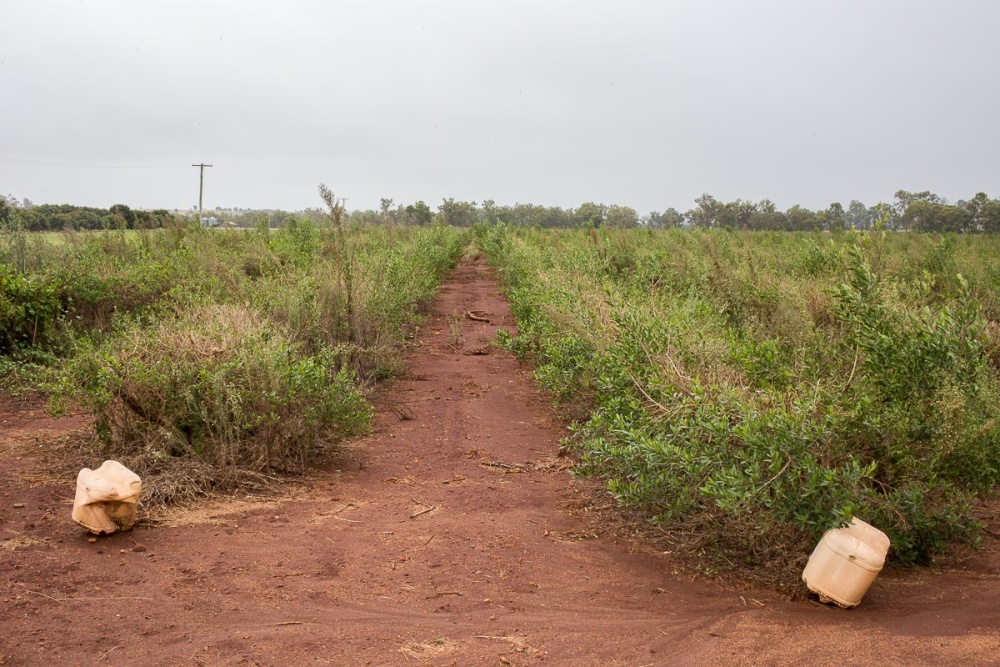
Planted in rows (Kingaroy, Australia)
Problem features
Birds in its native range eat the fruit and disperse the seed, which may cause it to become a problem weed. It is also known to sucker freely from the roots and regenerates rapidly after being cut back.
Scopolamine (Hyoscine) side effects include sleepiness, blurred vision, dilated pupils, dry mouth, respiratory failure and in rare cases, death.
Where it grows
References
Books
-
Brady, G. S. & Clauser, H. R & Vaccari, J. A. 2002, Materials handbook : an encyclopedia for managers, technical professionals, purchasing and production managers, technicians and supervisors, 15th ed., McGraw-Hill, New York
-
Doran, J. C & Turnbull, J. W. 1997, Australian trees and shrubs : species for land rehabilitation and farm planting in the tropics, 2nd ed, Australian Centre for International Agricultural Research (ACIAR), Canberra, Australian Capital Territory
-
Farooqi, A. A. & Sreeramu, B. S. 2004, Cultivation of medicinal and aromatic crops, Hyderabad University Press, Hyderabad
-
Floyd, A. G. 1979, N.S.W. rainforest trees, 2nd. ed., Forestry Commission of NSW, Sydney, Australia
-
Leakey, R. R. B et al. 1996, Domestication and commercialization of non-timber forest products in agroforestry systems : proceedings of an international conference held in Nairobi, Kenya, Food and Agriculture Organization of the United Nations (FAO) Press, Rome.
